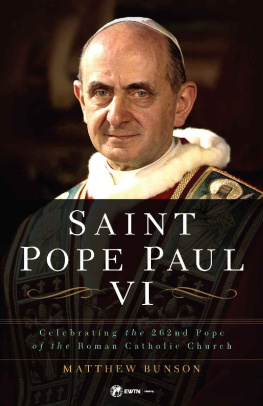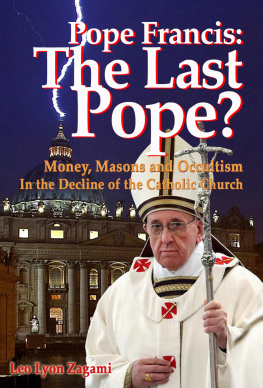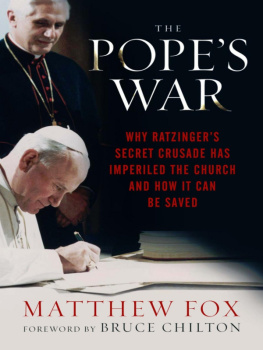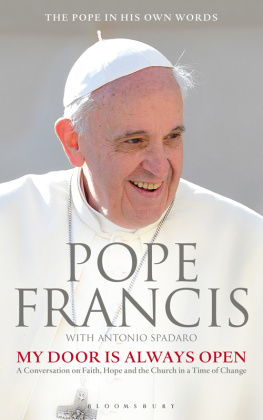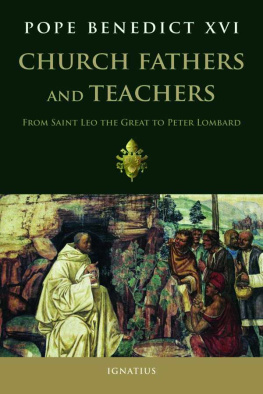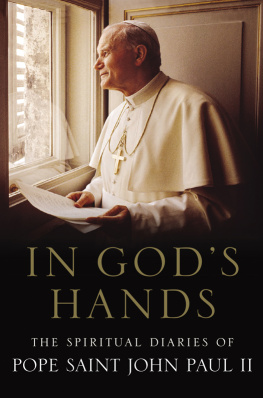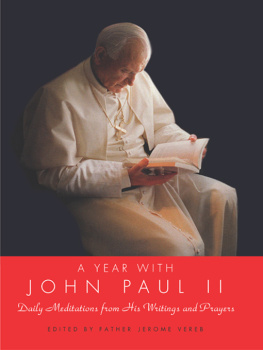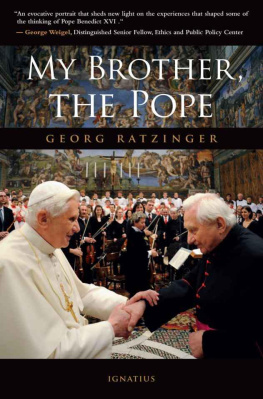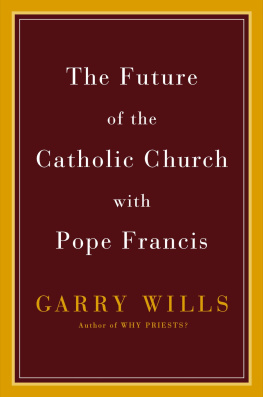Dr. Matthew Bunson - Saint Pope Paul VI : Celebrating the 262nd Pope of the Roman Catholic Church
Here you can read online Dr. Matthew Bunson - Saint Pope Paul VI : Celebrating the 262nd Pope of the Roman Catholic Church full text of the book (entire story) in english for free. Download pdf and epub, get meaning, cover and reviews about this ebook. year: 2018, publisher: Sophia Institute Press, genre: Religion. Description of the work, (preface) as well as reviews are available. Best literature library LitArk.com created for fans of good reading and offers a wide selection of genres:
Romance novel
Science fiction
Adventure
Detective
Science
History
Home and family
Prose
Art
Politics
Computer
Non-fiction
Religion
Business
Children
Humor
Choose a favorite category and find really read worthwhile books. Enjoy immersion in the world of imagination, feel the emotions of the characters or learn something new for yourself, make an fascinating discovery.
- Book:Saint Pope Paul VI : Celebrating the 262nd Pope of the Roman Catholic Church
- Author:
- Publisher:Sophia Institute Press
- Genre:
- Year:2018
- Rating:4 / 5
- Favourites:Add to favourites
- Your mark:
- 80
- 1
- 2
- 3
- 4
- 5
Saint Pope Paul VI : Celebrating the 262nd Pope of the Roman Catholic Church: summary, description and annotation
We offer to read an annotation, description, summary or preface (depends on what the author of the book "Saint Pope Paul VI : Celebrating the 262nd Pope of the Roman Catholic Church" wrote himself). If you haven't found the necessary information about the book — write in the comments, we will try to find it.
Saint Pope Paul VI : Celebrating the 262nd Pope of the Roman Catholic Church — read online for free the complete book (whole text) full work
Below is the text of the book, divided by pages. System saving the place of the last page read, allows you to conveniently read the book "Saint Pope Paul VI : Celebrating the 262nd Pope of the Roman Catholic Church" online for free, without having to search again every time where you left off. Put a bookmark, and you can go to the page where you finished reading at any time.
Font size:
Interval:
Bookmark:
Matthew E. Bunson
S aint
P ope P a ul V I
Celebrating the 262nd Pope of the Roman Catholic Church
EWTN PUBLISHING, INC.
Irondale, Alabama
Copyright 2018 by Matthew E. Bunson
Printed in the United States of America.
All rights reserved.
Cover design by LUCAS Art & Design, Jenison, MI.
On the cover: Papa Paolo VI, RealyEasyStar / Fotografia Felici / Alamy Stock Photo (E1H2P1).
Biblical references in this book are taken from the Revised Standard Version of the Bible: Catholic Edition, copyright 1965, 1966 the Division of Christian Education of the National Council of the Churches of Christ in the United States of America. Used by permission. All rights reserved.
Excerpts from the English translation of the Catechism of the Catholic Church, second edition, 1994, 1997, 2000 by Libreria Editrice VaticanaUnited States Conference of Catholic Bishops, Washington, D.C. All rights reserved.
Quotations from English translations of papal encyclicals are from the Vatican website (http://w2.vatican.va/content/vatican/en.html) Libreria Editrice Vaticana. All rights reserved. Used with permission.
No part of this book may be reproduced, stored in a retrieval system, or transmitted in any form, or by any means, electronic, mechanical, photocopying, or otherwise, without the prior written permission of the publisher, except by a reviewer, who may quote brief passages in a review.
EWTN Publishing, Inc.
5817 Old Leeds Road, Irondale, AL 35210
Distributed by Sophia Institute Press, Box 5284, Manchester, NH 03108.
ISBN 978-1-68278-071-8
For BB
In virtue of our own charism as Successor of Peter,
we feel compelled to speak to you a word of challenge, exhortation and encouragement. Permit us to open to
you our heart. Our sentiments are sentiments of
esteem, of interest and of love.
Address on the Occasion of the Canonization
of St. John Neumann (June 20, 1977 )
I must bear witness to his name: Jesus is the Christ, the Son of the living God (Matt. 16:16). He reveals the invisible God, he is the firstborn of all creation, the foundation of everything created. He is the Teacher of mankind, and its Redeemer. He was born, he died, and he rose again for us. He is the center of history and of the world; he is the one who knows us and who loves us; he is the companion and the friend of our life. He is the man of sorrows and of hope. It is he who will come and who one day will be our judge and we hope the everlasting fullness of our existence, our happiness.
Homily for Mass at Quezon Circle,
Philippines (November 29, 1970)
Contents
Introduction
On June 19, 1963, eighty members of the Sacred College of Cardinals processed into the Sistine Chapel to vote in the conclave to choose the successor to Pope St. John XXIII, who had died from stomach cancer on June 5 at the age of eighty-three.
The traditional drama of a conclave was heightened because Johns death had come in the middle of the Second Vatican Council. John had convened the ecumenical council, the twenty-first in the Churchs history, in 1962 to launch his vision of aggiornamento that is, encouraging the Church to proclaim the unchanging truths of the Catholic Faith in a language that the modern world could understand.
With the council on hold for the election of a new pope, many bishops wondered if the cardinals would choose a new Holy Father who would continue the work of the council, one who would redirect its energies and focus, or perhaps even one who would bring it to a close after one session, as a project to be buried with Pope John. One name, however, was on everyones mind.
There were, to be sure, several cardinals who could become the next pope so-called papabili but even before Johns passing, one was seen as the logical, perhaps even inevitable, prelate to ascend to the Chair of Peter: Cardinal Giovanni Battista Montini, archbishop of Milan.
On the afternoon of June 21, the Romans and the world watched for the results of the voting in the Sistine Chapel. Inside, beneath Michelangelos Last Judgment , the cardinals completed the fifth ballot, on which Cardinal Montini was, in fact, elected. When asked by what name he wished to be called, he responded that he would be Paulus Sixtus, Paul VI, choosing the name to honor St. Paul and to emulate him in his desire to evangelize the world.
Nine days later, a large crowd gathered in St. Peters Basilica for the formal installation Mass. Paul began his pontificate with a clear statement of his own humility, but also of certainty. He declared that he stood before the whole Church, trembling but confident, and accepted the keys of the Kingdom of Heaven keys that were heavy, powerful, and mysterious.
Pauls reference to the heaviness of the keys is significant, for it can be argued that the weight of the papacy had begun for Montini not on June 21, but at the moment he had become a cardinal in 1958.
By agreeing to receive the red hat from Pope John it was said that he had refused it from Pius XII in the 1950s he knew that he would almost certainly become pope. He was the first cardinal named by John after his election in 1958, but Montini had long been a major figure in the Vatican. His transfer to Milan in 1956, where he earned immense praise for his pastoral style and his openness to renewal, only added to his reputation.
Indeed, it was said that he would have been elected pope in 1958 had he been in the College at the time of Piuss death. There had even been speculation that the 1958 conclave might choose him anyway, in what would have been the first instance since 1378 in which a pope had been chosen who was not a cardinal.
That didnt happen, but by 1963 the hour had come. Much like Cardinal Eugenio Pacelli (Pope Pius XII) in 1939 and Cardinal Joseph Ratzinger (Pope Benedict XVI) in 2005, Montini entered the conclave knowing that he would almost certainly be called to the Petrine Office. All three men were elected in moments of drama or danger for the Church. Pacelli was chosen as the globe was plunging into the maelstrom of World War II, and Ratzinger became pope at the end of one of the longest pontificates in history one of a man already being called the Great and who would soon be canonized.
From the start, Paul had upon his shoulders not only the weight of years of expectation but the enormous task of bringing to a successful conclusion an era-defining council that he had not started. He would then have the duty of guiding the Church in its aftermath a period of shocking social and political change, including the sexual revolution.
In 1968, he issued the encyclical Humanae Vitae , which reaffirmed the Churchs teachings on contraception and family life in the face of pressure to embrace birth control. Paul would not budge, but the severity of the reaction and the open dissent took their toll. He never issued another encyclical.
The last years of his pontificate were a via crucis for him, and how best to understand those years remains the source of debate, controversy, and reflection. Through it all, he continued to defend the council, to speak on the implications of modernity for human life and the human person, and to call for Catholics to evangelize, to love the Eucharist, to be holy, and to be aware of the dangers of the age while understanding the signs of the times. He famously warned in a much misunderstood homily on the feast of Sts. Peter and Paul, on June 29, 1972, that in the face of doubt, uncertainty, problems, restlessness, dissatisfaction, confrontation in the Church, he had the terrible feeling that the smoke of Satan entered the temple of God from some fissure. The phrase was soon seen as a kind of epigraph for both his final years and the condition of the Church seven years on from the Second Vatican Council.
Paul died at the papal retreat of Castel Gandolfo, on August 6, 1978.
Next pageFont size:
Interval:
Bookmark:
Similar books «Saint Pope Paul VI : Celebrating the 262nd Pope of the Roman Catholic Church»
Look at similar books to Saint Pope Paul VI : Celebrating the 262nd Pope of the Roman Catholic Church. We have selected literature similar in name and meaning in the hope of providing readers with more options to find new, interesting, not yet read works.
Discussion, reviews of the book Saint Pope Paul VI : Celebrating the 262nd Pope of the Roman Catholic Church and just readers' own opinions. Leave your comments, write what you think about the work, its meaning or the main characters. Specify what exactly you liked and what you didn't like, and why you think so.

